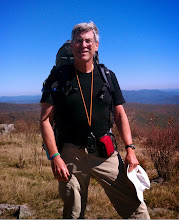Without warning, the brown object took off flying, immediately ruling out otters, raccoons, or nutria. It was a large hawk, and it was carrying part of an unfortunate creature in its talons. It landed nearby on a telephone pole, and started eating again. I reversed direction to go get my pack, and then went back towards the hawk. Along the way, I stopped at the site of the kill, which was a good sized bird. Only its beautifully marked wings and a chuck of flesh was left. I watched the hawk for a good 10 minutes, and then continued hiking.
I was out at sunrise to hike in Back Bay for the first time since late May. Unlike the last few times I hiked here, there was no need for bug repellent, as a stiff 15-20 knot breeze was blowing in the cool morning air. I hiked about 5 miles – 2.5 miles out and back – and although I didn’t see a ton of wildlife, the hawk was a spectacular sighting. In addition, I saw a rabbit, several American egrets, two great blue herons, and a couple of kingfishers.
I am thinking that the hawk’s prey may have been a kingfisher. I reflected on what it must be like to live in constant fear that if you let your vigilance down for a few seconds, then a larger, more powerful animal is going to come out of nowhere to kill you. It has got to be very stressful, but it is the cycle of life. The hawk has to eat, and it isn’t going to eat fruits and leaves. I am just glad to not be way down in the food chain, which I am sure early humans were. At one point, we were essentially cat food. Now, large cats are the endangered ones and will only survive if we humans can give them some space and stop killing them.
When I hiked through on the return hike, the remains of the unlucky bird remained on the ground near the dike. The hawk had moved its perch to another telephone pole nearby, and surveyed its domain. For one bird, sudden death from the sky. For another, a full stomach. It is the way of nature.
Here are some photos from the first of my three hikes today.
 Although I rarely see wildlife from it, this nice observation building was added a couple of years ago right beside some impoundments.
Although I rarely see wildlife from it, this nice observation building was added a couple of years ago right beside some impoundments. Remains of bird - maybe a kingfisher? - killed and eaten by a hawk.
Remains of bird - maybe a kingfisher? - killed and eaten by a hawk. The hawk perches on a telephone pole. Despite what I thought would be positive identification features - black bars on its face, white cheeks, and a solid brown back - I could not identify him later using my bird books.
The hawk perches on a telephone pole. Despite what I thought would be positive identification features - black bars on its face, white cheeks, and a solid brown back - I could not identify him later using my bird books. The dikes in the refuge impound fresh water, an important resource for the marshes wildlife.
The dikes in the refuge impound fresh water, an important resource for the marshes wildlife.
 Two different views across the marshes
Two different views across the marshes I saw two egrets and a kingfisher in this impoundment. But other times, I've seen so much wildlife at this spot that it looks like something out of "Wild Kingdom!"
I saw two egrets and a kingfisher in this impoundment. But other times, I've seen so much wildlife at this spot that it looks like something out of "Wild Kingdom!" This friendly bunny let me get within a few feet and just kept on munching his breakfast.
This friendly bunny let me get within a few feet and just kept on munching his breakfast.








How dramatic! What a story!
ReplyDeleteThanks Anne. It was pretty dramatic. I once say a small hawk attack and kill a woodpecker. It was sad to see in some ways but also I realized that the hawk starving to death would be pretty sad, too.
ReplyDelete